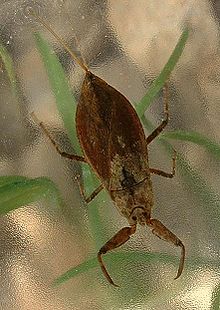Nepa cinerea
- View a machine-translated version of the German article.
- Machine translation, like DeepL or Google Translate, is a useful starting point for translations, but translators must revise errors as necessary and confirm that the translation is accurate, rather than simply copy-pasting machine-translated text into the English Wikipedia.
- Do not translate text that appears unreliable or low-quality. If possible, verify the text with references provided in the foreign-language article.
- You must provide copyright attribution in the edit summary accompanying your translation by providing an interlanguage link to the source of your translation. A model attribution edit summary is
Content in this edit is translated from the existing German Wikipedia article at [[:de:Nepa cinerea]]; see its history for attribution. - You may also add the template
{{Translated|de|Nepa cinerea}}to the talk page. - For more guidance, see Wikipedia:Translation.
| Nepa cinerea | |
|---|---|
 | |
| Scientific classification | |
| Domain: | Eukaryota |
| Kingdom: | Animalia |
| Phylum: | Arthropoda |
| Class: | Insecta |
| Order: | Hemiptera |
| Suborder: | Heteroptera |
| Family: | Nepidae |
| Subfamily: | Nepinae |
| Genus: | Nepa |
| Species: | N. cinerea |
| Binomial name | |
| Nepa cinerea | |
Nepa cinerea is a species of water scorpion (Nepidae), found in most of Europe, including the British Isles, as well as North Africa and southern and northern Asia.[2]
Habitat and Biology
It lives in ponds, small rivers, and stagnant water, and feeds upon aquatic animals, especially insects.
Respiration in the adult is effected by means of the caudal process, which consists of a pair of half-tubes capable of being locked together to form a siphon by means of which air is conducted to the tracheae at the apex of the abdomen when the tip of the tube is thrust above the surface of the water. In immature forms, the siphon is undeveloped and breathing takes place through six pairs of abdominal spiracles. The eggs, laid in the stems of plants, are supplied with seven filamentous processes which float freely in the water.
References
External links
 Media related to Nepa cinerea at Wikimedia Commons
Media related to Nepa cinerea at Wikimedia Commons Data related to Nepa cinerea at Wikispecies
Data related to Nepa cinerea at Wikispecies









